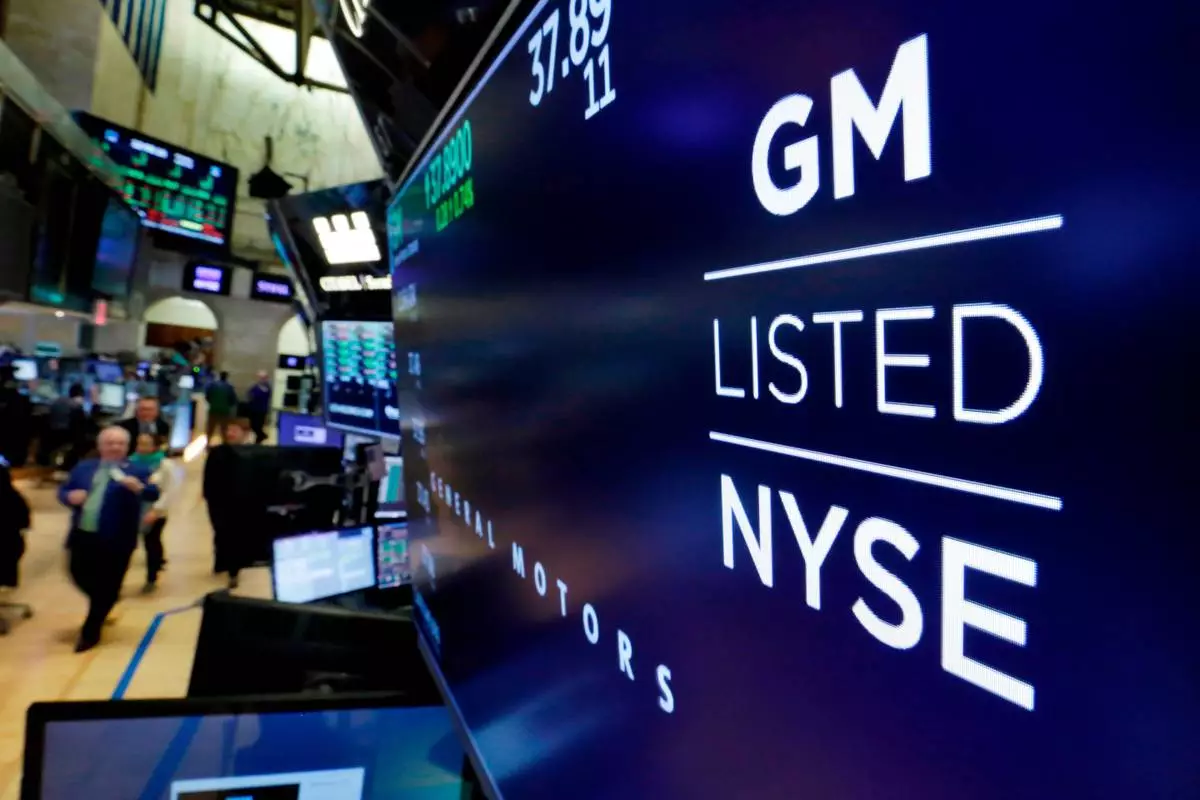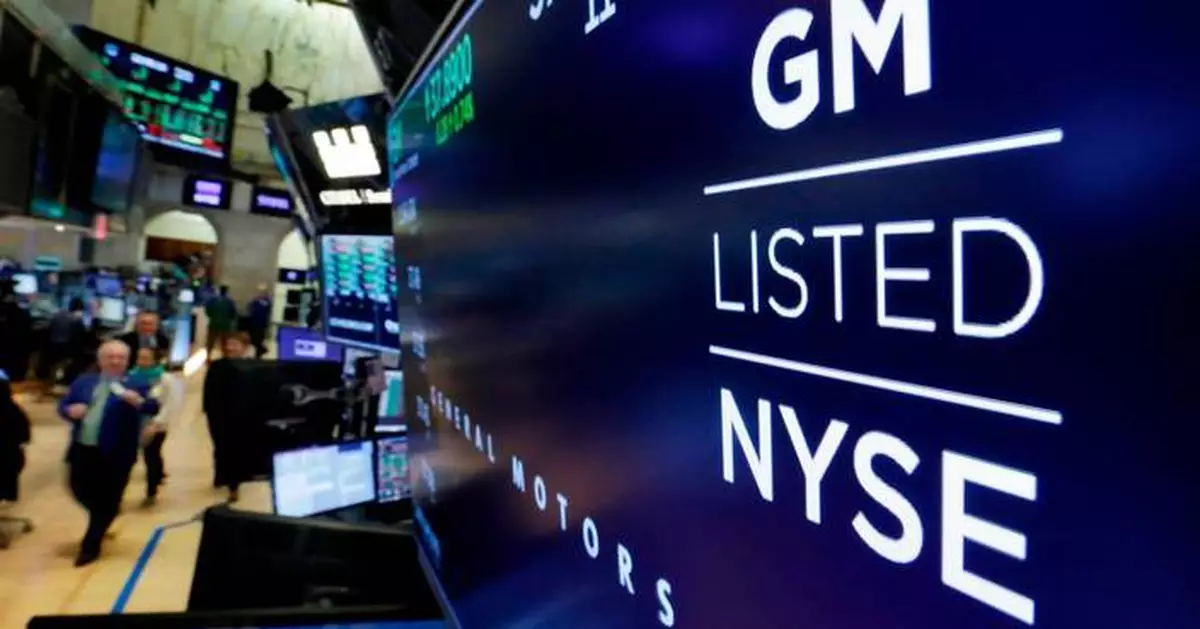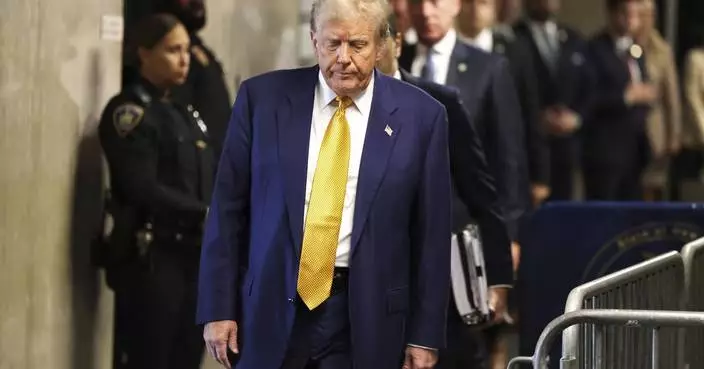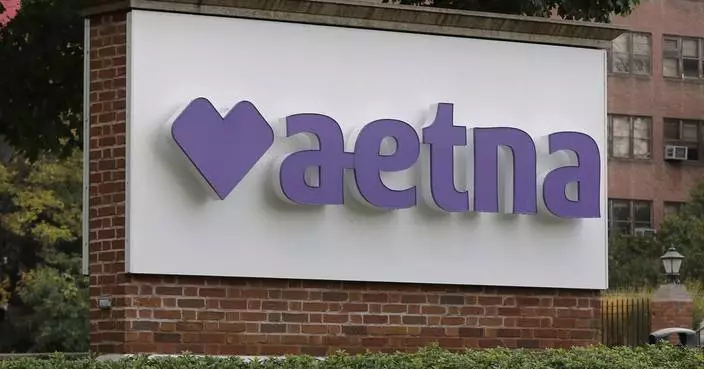DETROIT (AP) — Despite a small dip in U.S. vehicle sales, General Motors' first-quarter net income rose more than 25% on strong deliveries of pickup trucks and other higher-profit vehicles.
The automaker said that while its average sales price per vehicle was down slightly from last year at just under $50,000, pickup sales remained strong, and it's not seeing the price erosion across its lineup that other companies have experienced.
GM on Tuesday said it made $2.97 billion from January through March, with revenue increasing 7.6% over the same period a year ago to just over $43 billion. That topped the $41.15 billion that analysts polled by FactSet were calling for.
Excluding one-time items the company made $2.62 per share, easily beating Wall Street estimates of $2.13 per share.
Dan Ives of Wedbush said in a note to clients that GM delivered a solid performance as it concentrates on profitability and managing expenses.
“This was a major ‘prove me’ quarter for GM and shows the long awaited turnaround now appears to be underway for Barra & Co.,” he wrote, referring to CEO Mary Barra.
GM's better-than-forecast prices also allowed the company to raise its full year net income guidance slightly to a range of $10.1 billion to $11.5 billion, up from $9.8 billion to $11.2 billion. Adjusted 2024 earnings per share guidance rose to a range of $9 to $10 from $8.50 to $9.50.
Analysts are looking for earnings of $8.89 per share for the year.
Shares of the company, which is planning to move its Detroit headquarters to a new downtown office building next year, jumped more than 5% in early morning trading.
Chief Financial Officer Paul Jacobson said prices dropped a little because GM sold a higher share of lower-cost vehicles such as the Chevrolet Trax small SUV, which starts at $21,495 including shipping. “The portfolio as a whole has been pretty strong,” he said, noting that pickup truck sales were up 3% in the U.S.
The company still has assumed that prices will drop 2% to 2.5% for the full year, but has not seen the decline yet, Jacobson said.
Retail sales of electric vehicles rose during the quarter, and GM is producing more of its own batteries, he said. The company is on track to hit a mid single-digit profit margin on EVs next year.
CEO Mary Barra, in a letter to shareholders, said that GM is seeing “good early sales momentum” for vehicles like the Cadillac LYRIQ, an electric SUV. The company has also benefited from a significant drop in the cost of battery cells and lower raw material prices, she added.
GM's battery module production is up 300% over the past six months. Barra says the company projects doubling its current capacity by the end of the summer.
“Improving module availability is enabling higher vehicle production, which we believe will help us win even more new customers in the growing U.S. EV market,” she said.
Jacobson noted during GM's conference call that adjusting pricing on its 2024 Blazer EV has been well received by dealers and customers.
During the quarter, the company made $3.84 billion before taxes in North America, but lost $10 million in its international operations, including a $106 million loss in China.
Barra said that there have been challenges with China over the last several years, including the COVID-19 pandemic and supply chain issues, but that GM remains committed to the country long term.
“We believe that it's a market that over the medium term will have substantial growth,” she added.
The automaker's troubled Cruise autonomous vehicle unit lost $519 million pretax as it tries to recover from a serious crash and allegations of a cover-up in California. Barra said Cruise, which had suspended testing and robotaxi rides after losing its California license, returned to testing in Phoenix to update mapping and gather road information.
Jacobson said that full-year expenses for Cruise at anticipated to be around $1.7 billion.
Michelle Chapman in New York contributed to this report.

FILE - In this April 23, 2018, file photo, the logo for General Motors appears above a trading post on the floor of the New York Stock Exchange. General Motors reports earnings on Tuesday, April 23, 2024. (AP Photo/Richard Drew, File)
DETROIT (AP) — The U.S. government on Friday loosened some rules governing electric vehicle tax credits, potentially making more EVs eligible for credits of up to $7,500 but leading critics to accuse the Biden administration of helping China.
The Treasury Department announced final regulations for the credits under the 2022 Inflation Reduction Act, giving automakers more time to comply with some provisions about where battery minerals can come from.
The credits range from $3,750 to $7,500 for new EVs. There's also a $4,000 credit for used ones.
They're aimed at juicing demand for EVs in an effort to reach a Biden administration goal that half of all new vehicle sales be electric by 2030. This year the credits are available at the time a vehicle is purchased from an authorized dealer rather than waiting for an income tax refund.
Qualifying for the credits depends on a person's income, the price of the vehicles and requirements related to battery makeup and minerals that get tougher each year. To get the credits, EVs must be assembled in North America. Some plug-in hybrids also can qualify.
Starting this year, complex rules are being phased in to promote development of a domestic electric vehicle supply chain. The rules would limit EV buyers from claiming the full tax credit if they purchase cars containing battery materials from China and other nations “of concern” that are considered hostile to the United States. Those include Russia, North Korea and Iran.
Under the final rule, however, small amounts of graphite and other minerals used in batteries would be exempt from the restriction until 2027, because their country of origin is nearly impossible to trace, officials said. Without the exemption, some vehicles that met nearly all of the requirements could get knocked out of tax credit eligibility due to tiny amounts that couldn’t be traced, Treasury said.
The National Mining Association slammed the new exemptions as a giveaway to China.
“Congress created these tax incentives to secure our supply chains and generate American jobs while supporting EV adoption. They did not intend for loopholes to be created that essentially amount to a blank check from the American taxpayer to China,” said Rich Nolan, the mining lobby’s president and CEO.
West Virginia Sen. Joe Manchin, the Democratic chairman of the Senate Energy and Natural Resources Committee, said that through the new rule, the Biden administration “is effectively endorsing ‘made in China.’ ”
Manchin, who played a key role in passage of the Inflation Reduction Act, President Joe Biden’s landmark climate law, said the law specifically prohibits EVs that contain materials from foreign adversaries such as China and Russia from being eligible for the tax credit after 2024. “But now Treasury has provided a long-term pathway for these countries to remain in our supply chains. It’s outrageous and illegal,″ he said.
This year half of the critical minerals in an EV's battery have to be mined or processed in the U.S., or a country with which it has a free trade agreement. Sixty percent of the battery parts have to be made or assembled in North America.
Starting in 2025, batteries with any critical minerals from nations of concern would not be eligible for any tax credits. But after getting comment from the auto industry and others, treasury officials decided to loosen that restriction.
The rule issued Friday is likely to make more EVs eligible for credits in 2025 and 2026, but the auto industry says that's difficult to tell until automakers finish tracing the origin of all the minerals.
“The EV transition requires nothing short of a complete transformation of the U.S. industrial base," John Bozzella, CEO of the Alliance for Automotive Innovation, a large industry trade group, said in a statement. “That’s a monumental task that won’t – and can’t – happen overnight.”
The rule change, he said, “makes good sense for investment, job creation and consumer EV adoption.”
At present, China dominates crucial parts of EV battery supply and production, even as automakers race to establish key mineral and components efforts elsewhere.
Of 114 EV models currently sold in the U.S., only 13 qualify for the full $7,500 credit, the automotive alliance said.
Despite the tax credits, sales of electric vehicles grew only 3.3% to nearly 270,000 from January through March of this year, far below the 47% growth that fueled record sales and a 7.6% market share last year. The slowdown, led by Tesla, confirms automakers’ fears that they moved too quickly to pursue EV buyers. The EV share of total U.S. sales fell to 7.15% in the first quarter, according to Motorintelligence.com.
“The Inflation Reduction Act’s clean vehicle credits save consumers up to $7,500 on a new vehicle, and hundreds of dollars per year on gas, while creating good paying jobs and strengthening our energy security,” Treasury Secretary Janet Yellen said in a statement.
AP writer Daly reported from Washington.

President Joe Biden speaks during a State Dinner at the White House in Washington, Thursday, May 2, 2024, to honor the 2024 National Teacher of the Year and other teachers from across the United States. (AP Photo/Mark Schiefelbein)

Sen. Joe Manchin, D-W.Va., asks a question during a Senate Energy and Natural Resources Committee hearing to examine the president's proposed 2025 Department of the Interior budget on Capitol Hill Thursday, May 2, 2024, in Washington. (AP Photo/Mariam Zuhaib)

FILE - A 2023 Ford Mustang Mach-E charges, Friday, March 8, 2024, at an electric vehicle charging station in London, Ohio. The U.S. government has loosened some rules governing electric vehicle tax credits a bit, potentially making more EVs eligible for credits of up to $7,500. The Treasury Department announced final regulations for the credits under the 2022 Inflation Reduction Act on Friday, May 3, giving automakers more time to comply with some provisions about where battery minerals can come from. (AP Photo/Joshua A. Bickel, File)













